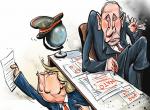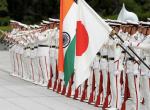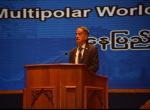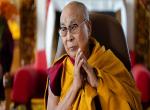(Given below is the keynote address delivered by Brig Vinod Anand, Senior Fellow and Editor, VIF at “Forum on Myanmar beyond 2025: Challenges and Opportunities in the Multipolar World” held at Nay Pyi Taw, Myanmar on 21 March 2025)
Excellencies, Ladies and Gentlemen
Let me first congratulate Dr. U Ko Ko and his colleagues for a successful opening of the ‘Myanmar Narrative’ Think Tank and I am happy to be part of the inaugural conference.
General: Multipolar World Order and Myanmar
If one scans the global strategic environment, the world is going through profound changes and some of these changes are very disruptive which would impact the shape of things to come. It is axiomatic that the unipolar moment enjoyed by the US has long since passed and the world has moved towards diffusion and distribution of political and economic power to several emerging economies and power centres. This shift towards multipolarity has largely occurred due to the fast-paced changes that are taking place on geopolitical, economic and technological firmaments; this has also been enabled by some of the regional organizations like ASEAN, BRICS and some others that have acquired more heft and ascendancy over the years. Besides this the western discourse which has even dominated the socio-cultural thought processes of Easten and indigenous civilisations is also being increasingly challenged with emphasis on their own socio-cultural outlooks and approaches. However, the ongoing transition towards multipolarity is unlikely to come about without turbulence in case the competing power centres continue to engage in games of domination.
Further, the global governance has also weakened as the UN and the multilateral institutions have not lived up to their mandate. The IMF, World Bank and WTO have also been found wanting in fulfilling their avowed objectives and adherence to their charter. Such a state of affairs has resulted in the world facing many unresolved conflicts at present and that has, in turn, adversely impacted the environment for economic development, peace and stability. The United Nations Security Council has not lived up to its mission objectives of ensuring security and peace in the turbulent world of today.
With above as background, how does one place Myanmar in the evolving strategic environment and how can it realise its true potential in the coming years. Even in normal times there would be many complex challenges for transforming Myanmar into a reasonably prosperous nation and exploiting many of the opportunities that are being presented in the evolving world order. Neighbouring countries and relationships with them besides the other major powers and emerging powers at the global scene, undoubtedly, remain an important factor for whatever approaches Myanmar wishes to adopt for promoting peace, stability and development in the country. India, China, Thailand, Laos, Bangladesh and members of ASEAN in addition to other regional powers have been playing and are likely to play significant roles in addressing several facets of issues being faced by Myanmar and its people. There is also no gainsaying in the fact that achieving internal cohesion, peace and reconciliation would be a necessary condition for stability, economic growth and development of Myanmar.
Bilateral Relationship
From an Indian perspective Myanmar is a strategically important country that is resource rich nation, and which provides land connectivity to mainland Southeast Asia enabling India to realise objectives and missions of its Act East Policy outlined in 2014 (earlier version adopted in 1991 was known as Look East Policy). India’s connectivity projects in Myanmar and beyond are mutually beneficial with aim of promoting people to people links, trade and transportation among many other aspects of connectivity. While the instability in areas through which such projects pass (i.e. Kaladan Multimodal Transit Transport Project; India-Myanmar- Thailand Trilateral Highway project) has been one of the factors for non-completion of the projects there could also be some other connected issues. India has also supported many other development programmes in Myanmar like Border Area Development Programme, establishment of Indian Institutes of Technology, Industrial Training Centre etc., provision of humanitarian assistance and disaster relief. Recently, i.e. in October last year India has signed MOUs with Myanmar for undertaking several Quick Impact Projects in areas of agricultural development, skill development, education etc. which would be instrumental in contributing to socio-economic development of Myanmar.
Looking back at the India-Myanmar relationship, both countries gained independence from their colonial rule within five months of each other i.e. 15 Aug 1947 and 04 Jan 1948. Though there have been up and downs in the bilateral relationship since then India has maintained a constructive dialogue with Myanmar whatever may be the nature of political dispensation there. Whether it was Gen Ne Win rule (1962) or it was later in 1988, India continued to engage with Myanmar because of the need for a mutually beneficial relationship. As a rule, India has endeavoured to engage with both the ruling dispensation as well as the democratic forces. The 2010 elections based on 2008 Myanmar Constitution was viewed by India as a good beginning for democracy despite there being some inadequacies in the nature of distribution of power in the resulting power structures. The 2015 elections in Myanmar had carried the mandate forward signifying that democratic transition was making discernible progress.
Holding of ASEAN Summit by Myanmar and PM Modi’s visit to Myanmar in Nov 2014 for 12th India-ASEAN Summit showcased the rising profile of Myanmar. And it was in Nay Pyi Taw that PM Modi had unveiled India’s Act East Policy then. Later, PM Modi paid a bilateral visit to Myanmar in Sept 2017. After that bilateral relations were on an ascending trajectory that covered a host of new areas besides the existing initiatives. The move by Myanmar towards greater democratisation and peace and reconciliation had received strong support and encouragement from India.
Even in recent times India has continued to engage with Myanmar with External Affairs Minister S. Jaishankar meeting Myanmar’s Deputy Prime Minister and Foreign Minister Than Shwe in a high-level dialogue in July 2024 on the sidelines of BIMSTEC (Bay of Bengal Initiative for Multi Sectoral Technical and Economic Cooperation) Foreign Ministers conference. Amongst several other issues Dr Jaishankar had also called for “early return to the path of democratic transition”. Earlier in Dec 2021 and later in Nov 2022 India’s Foreign Secretaries then had visited Myanmar and among many other concerns of mutual interest had conveyed India’s interest in Myanmar’s return to democracy.
Myanmar & International Community
Myanmar’s efforts in its march towards democracy had also created positive resonance amongst the western nations and the US, leading to a favourable climate for investment, business and trade and consequently for economic growth in Myanmar. US and western nations had eased their sanctions with Hilary Clinton visiting Myanmar in Dec 2011 and President Obama in Nov 2012 and observed that ‘there was something happening in this country that cannot be reversed’. The then President Thein Sein in his address to the UN General Assembly in Sept 2012 took great pride in the fact that his country was “leaving behind a system of authoritarian govt wherein the executive, legislative and judicial powers were centralized” and replacing it with “a strong, viable Parliament following a practice of check and balance”.
The Myanmar elections of Nov 2020 and its mandate was expected to further the process of democratic transition, but this process was stalled because of the events of Feb 2021. The ASEAN came out with a Five Point Consensus (FPC) as a step towards resolution of the internal conflict in Myanmar through dialogue among all stakeholders, complete cessation of violence, provision of humanitarian relief. India has been supportive of the ASEAN efforts in addressing the Myanmar conflict. However, the ASEAN initiative though laudable has not met with much success.
Additionally, at the international level, human rights and treatment of ethnic minorities, displacement of people, humanitarian crisis etc has been receiving increased attention.
Brief Review of Economic Challenges
While the ASEAN and economies in Myanmar’s neighbourhood have shown appreciable growth, according to one report the economic performance of Myanmar has been the weakest in SE Asia. Real GDP is estimated to decline by 1% in FY 24/25. Some of the causes for this below par performance in agricultural, manufacturing and industry and services sectors could also have been due to the Covid-19 onslaught besides the challenging internal security conditions. A study of SAC (State Administration Council) data shows high inflation rates with food prices having tripled in last four years or so. The exports which had shown upward trend in 2022 had declined in 2023. Textiles sector including the garment industry that had received a setback due to Covid continued to face challenges.
The areas not under full control of SAC are deprived of benefits of trade with other countries and have limited scope for bettering the lot of their people who are facing difficulties in obtaining even the daily necessities, healthcare etc. Threats of further sanctions on Myanmar, if converted into substantive actions would further aggravate the already adverse impact of such sanctions.
Further, the informal economy associated with narcotics and drugs appears to be thriving under the prevailing unsettled conditions. This is another challenge that is being faced by India and Myanmar’s other neighbours. In addition, the running of some cyber scam centres in Myanmar by certain unruly elements has negative implications for countries like India. Only good governance and tight control on law and order can prevent continuation of such undesirable activities.
Looking Beyond 2025
SAC’s decision to hold elections in Dec 2025 or Jan 2026 is a welcome step and needs to be appreciated. As it is the elections have been postponed many times with emergency being extended continuously. However, conditions to hold elections all over the country would need to be conducive for successful participation by all the concerned parties involved. All the ethnic groups and parties need to be consulted before the elections are held. The SAC has endeavoured to reach agreements with some of the groups; would it be possible to reach a modus vivendi with majority of the stakeholders if not all?
Conduct of elections and return to democracy even though not prefect would also be a positive signal to the international community and major global and regional powers who, most likely, would enhance their political and economic engagement with Myanmar. There would also be possibilities of graduated reduction of western sanctions which would be a catalyst for economic development and growth of Myanmar.
Nevertheless, the biggest challenge in the coming years for Myanmar would be achieving peace, reconciliation and stability among various ethnic groups, political factions and other interest groups. Despite the wide chasm between the SAC and other contending parties on adopting approaches towards resolution to the current conflict, one can hope and work for an amicable solution to the ongoing crisis. Evidently, looking at the history of Myanmar it would not be an easy task, but sustained attempts need to be made to arrive at a new kind of Panglong Agreement involving all the stakeholders. Joining the mainstream of evolving multipolar world order would enable Myanmar to exploit the opportunities being presented in this new era in most diverse and useful ways for its socio-economic development growth and betterment of its people.
Thank You!
(The paper is the author’s individual scholastic articulation. The author certifies that the article/paper is original in content, unpublished and it has not been submitted for publication/web upload elsewhere, and that the facts and figures quoted are duly referenced, as needed, and are believed to be correct). (The paper does not necessarily represent the organisational stance... More >>
Image Courtesy: Author











Post new comment